Colorado State, in Partnership with CU-Boulder and UC-Berkeley Annouce $17 Million NSF Grant for Engineering Research Center
FOR IMMEDIATE RELEASE: Wednesday, October 1, 2003
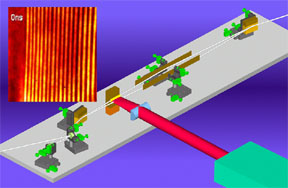 |
| A Compact Extreme Ultraviolet Interferometer developed at Colorado State University. |
(970) 491-1545
Brad.Bohlander@colostate.edu
FORT COLLINS - Officials from three leading research universities today announced a $17 million National Science Foundation grant to develop laser technologies that will be used to help create the smallest, most powerful computer circuits ever developed as well as other advanced nanotechnologies.
Technology developed through research conducted at the new NSF Engineering Research Center for Extreme Ultraviolet Science and Technology, headquartered at Colorado State and a joint collaboration among Colorado State, the University of Colorado at Boulder and the University of California at Berkeley, is expected to create significant national economic benefits in the near future.
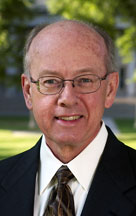 |
| Colorado State University President Larry Penley describes the scientific, technical and economic benefits of extreme ultraviolet light technologies. |
"Being awarded a National Science Foundation Engineering Research Center is one of the highest honors given to an engineering college," said Larry Edward Penley, president of Colorado State. "Colorado State University is pleased to be leading this national research center that will help create amazing new nanotechnologies and generate significant economic benefits for the United States."
The one promising region of the electromagnetic spectrum of light that remains relatively unexploited is the extreme ultraviolet or soft X-ray range. The goal of the center is to develop solutions to a variety of challenging scientific and industrial problems by using short wavelength light in the extreme ultraviolet range of the electromagnetic spectrum.
The new ERC is positioned to play a significant role in supporting a number of industries as the use of EUV radiation is expected to dramatically increase during the next 10 years, due in part to the widespread adoption of EUV lithography, an advanced process of producing semiconductor nanostructures for use as integrated circuits in computers and other technologies.
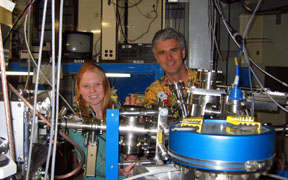 |
| Researchers at the University of California-Berkeley, the University of Colorado-Boulder and Colorado State University will conduct collaborative EUV laser research. Photo courtesy of the University of California-Berkeley. |
The new Engineering Research Center, or ERC, combines the complementary expertise of researchers at two Colorado universities that are among the world leaders in developing compact extreme ultraviolet, or EUV, laser light sources with the strong track record in extreme ultraviolet optics and applications at Berkeley. The project's principal investigators include Colorado State's Jorge Rocca and CU's Margaret Murnane and Henry Kapteyn, who are renowned for their contribution to compact EUV laser sources, and Berkeley's David Attwood and Erik Anderson who are leaders in EUV applications and engineered nanostructures. The center also has significant industry and national laboratory involvement.
"EUV light is well positioned to become an important enabling technology that will contribute substantially to the scientific, technical and economic health of the country," said Rocca, a professor at Colorado State and director of the ERC. "We are excited to be working on this important project with outstanding colleagues at CU-Boulder and UC-Berkeley and several outreach institutions."
Compact laser technologies, recently developed at CU-Boulder and Colorado State, have made small EUV laser sources that fit on a single table practical for the first time. These new tools make it possible to implement advanced EUV science in a small laboratory, in some cases with powers and accuracy previously available only at one of the few building-size EUV facilities around the nation. At the completion of the 10-year ERC effort, leaders expect that EUV science and technology will move from a handful of large national facilities to a large number of university and industrial laboratories.
"Most EUV science and technology development is presently being conducted at a handful of large national light source facilities, but to realize the full potential of EUV, there is an urgent need to make this technology accessible to university, national and industrial laboratories," said Murnane, a professor at CU-Boulder and deputy director of the ERC. "Throughout the lifespan of the ERC, we expect to make compact coherent EUV sources at significantly shorter wavelengths than is now possible, and to reduce their scale to desktop, and in some cases, even laptop size."
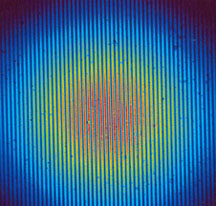 |
| An interference pattern showing the high spatial coherence of a table-top capillary discharge laser developed at Colorado State University. |
Nationally and worldwide, there is a massive research push to develop nanotechnology, the science of creating electronic circuits and devices that are designed and built from single atoms and molecules on a scale of nanometers. One nanometer is one billionth of one meter; the size of one human hair is approximately 1,000 nanometers.
Nanostructures are so small that they cannot be seen with visible light. EUV light will be a key component for the creation of nanoscale technologies.
"EUV wavelengths correspond to the scale relevant to nanotechnology," said Attwood, director of UC-Berkeley's Center for X-Ray Optics and associate director of the ERC. "For the nation to make rapid progress in this competitive field, a wide variety of techniques are needed to make it possible to see small objects, to manipulate and to manufacture them."
Extreme ultraviolet technology is positioned to become the critical enabling technology of the near future, and the NSF ERC in EUV is positioned as a leader to drive this technology.
Extreme ultraviolet technology has been identified by the International Sematech Research Consortium as the prime candidate for creating advanced integrated-circuits for devices such as computers, starting with high volume production in 2007. Extreme ultraviolet technology will be critical to allow the continuation of the reduction of the sizes and increase the memory of these electronic devices about every two years, as stated by the Industrial Technology Road Map for Semiconductors.
By 2009, six major technology companies, including IBM, Motorola and Intel, plan to produce computer technologies using EUV radiation with chips measuring 16 nanometers that have speeds of 20 GHz, much smaller and about 10 times faster than current technologies.
One long-term goal of the ERC is to create biological soft x-ray microscopy that can image minute details of individual living cells. Other exciting opportunities in science will arise from the possibility of focusing EUV radiation to unprecedented small spot sizes, short pulse durations and extremely high intensities, and will open up a variety of new areas of investigation including surface, chemical and materials dynamics studies, EUV nonlinear optics, biological studies and the development of a new generation of nanotechnologies.
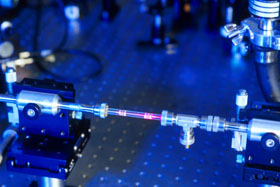 |
| Researchers study laser technology using a hollow fiber extreme ultraviolet light source. Photo courtesy of the University of Colorado-Boulder. |
In addition to research, the center has an ambitious education and outreach plan that will transmit the excitement of frontier research to all levels of education and reach underrepresented minorities in science and engineering.
At the university level, the ERC will spur modernization of the curriculum through new courses. At the middle- and high-school levels, outreach programs that will be implemented that will expose teachers and students to 21st century research.
"A major theme of the ERC educational vision is to increase diversity in science and engineering," said Carmen Menoni, a professor at Colorado State and co-principal investigator of the ERC. "To accomplish this, the ERC has developed alliances with predominantly minority four-year colleges and will collaborate with programs at the three core institutions that have proven track records in recruiting underrepresented students in science and engineering."
Outreach will involve year-round research experiences with affiliations between undergraduates and faculty from the ERC and the following institutions that serve underrepresented groups: Agnes Scott College, Bryn Mawr College, Colorado State University-Pueblo, Morehouse College and Spelman College. Harvey Mudd College, Sewanee University of the South, Hamline University, Brigham Young University, Massachusetts Institute of Technology, University of California Davis at Livermore, and Lawrence Livermore National Laboratory will also be outreach affiliates in research and education.
The ERC in EUV is one of four new centers created as a result of a recent proposal competition, in which more than 100 teams competed for the prestigious Engineering Research Center designation. The NSF currently funds 24 engineering research centers nationwide. The centers are designed to partner university researchers with industry and government practitioners, in order to tackle issues too complex and expensive for one sector alone. All engineering research centers must also have a large educational component.
For more information about the Engineering Research Center for Extreme Ultraviolet Science and Technology, go on the Web to http://www.newsinfo.colostate.edu/index.asp?page=685848753.